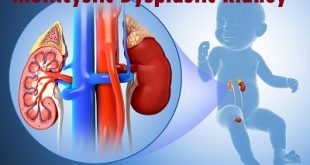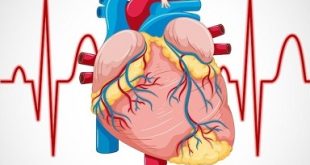Definition
Mitral valve prolapse (MVP) is a condition in which the heart’s mitral valve doesn’t work well. The flaps of the valve are “floppy” and may not close tightly. These flaps normally help seal or open the valve. Much of the time, MVP doesn’t cause any problems. Rarely, blood can leak the wrong way through the floppy valve. This can lead to palpitations, shortness of breath, chest pain, and other symptoms. (Palpitations are feelings that your heart is skipping a beat, fluttering, or beating too hard or too fast.)
The mitral valve is located between the left atrium and the left ventricle and has 2 flaps. Normally the flaps are tightly closed by small tendon or “cords” that connect the flaps to the muscles of the heart. This closure prevents blood from flowing backward. In MVP, the flaps enlarge and stretch inward toward the left atrium, sometimes “snapping” during heart contraction. This may allow some backflow or regurgitation of blood into the left atrium. MVP usually does not need to be treated because it is rarely a serious condition, and it doesn’t damage the heart. However, regular check-ups with a doctor are advised.
Epidemiology
The prevalence of this entity is 1% to 2.5% of the population. It is the most common cardiac valvular anomaly in developed countries. Myxomatous degeneration is the main etiology of prolapsing valvar leaflets, explaining the fact that MVP is uncommon before adolescence. Indeed, the prevalence of MVP was 0.7% in a population of healthy teenagers.
Types
There are 2 forms of MVP: primary and secondary.
Primary MVP
Primary MVP means the mitral valve is abnormal because of one or more of these changes:
- One or both of the flaps are too large and thick
- The flap surfaces are scarred
- The tendon cords are thinner or longer than they should be
- There are fibrin deposits on the flaps
Primary MVP is most often an isolated disease. But is can be linked to other valve or skeletal problems. Some rare instances of MVP are hereditary.
Secondary MVP
In secondary MVP, another disease is linked to MVP. Often the valve flaps are not thickened. Prolapse occurs for other reasons. The prolapse may be from:
- Damage caused by decreased blood flow from coronary artery disease to the muscles attached to the tendon cords
- Functional changes in the heart muscle
- Damage to valve structures caused by heart attack, rheumatic heart disease, valve infection, or hypertrophic cardiomyopathy. Hypertrophic cardiomyopathy is when the left ventricle of the heart is larger than normal.
- Damage caused by a connective tissue disorder such as Marfan syndrome
Mitral Valve Prolapse Risk factors
Factors that may increase your chance of getting mitral valve prolapse include:
- Family histories of mitral valve prolapse
- Female gender
- Age: 14 to 30
- Scoliosis
- Thin chest diameter
- Low body weight
- Low blood pressure
- Chest wall deformities
- Marfan syndrome
- Grave’s disease
- Ehlers-Danlos syndrome
- Ebstein’s anomaly
Causes
Common causes of mitral valve prolapse include:
- Connective tissue disease
- Coronary artery disease
- Hypertrophic obstructive cardiomyopathy: A condition in which the ventricular walls have gotten excessively thick, making it difficult for the heart to pump blood
- Myxomatous proliferation, a tumor near the valve
- Rheumatic heart disease: Damaged heart valves and heart failure in patients with a history of rheumatic fever
Symptoms of Mitral Valve Prolapse
MVP may not cause any symptoms. Symptoms may vary depending on the degree of prolapse present. The presence of symptoms doesn’t necessarily match the severity of MVP.
These are the most common symptoms of MVP:
- Fast or irregular heartbeats (palpitations): This may be the result of irregular heartbeats or just the sensation of the valve closing when the heart rhythm is normal.
- Chest pain: Chest pain linked to MVP is different from chest pain associated with coronary artery disease. Usually, the chest pain is not like classic angina, such as pain with exertion, but it can happen often, can be very uncomfortable, and can affect your quality of life.
- Anxiety
- Hyperventilation
- Exercise intolerance
- Dizziness
Depending on the severity of the mitral regurgitation or leak, the left atrium or left ventricle may become enlarged, leading to symptoms of heart failure. These symptoms include weakness, tiredness, dizziness, and shortness of breath. The symptoms of mitral valve prolapse may look like other medical conditions or problems. Always see a healthcare provider for a diagnosis.
Mitral Valve Prolapse Complications
- Palpitations are sensations of fast or irregular heartbeats. In most patients with mitral valve prolapse, palpitations are harmless. In very rare cases, potentially serious heart rhythm abnormalities (for example, atrial fibrillation) may underlie palpitations and require further evaluation and treatment. Moreover, pulmonary hypertension may develop and lead to heart failure.
- Sharp chest pains are reported in some patients with mitral valve prolapse, which can be prolonged. Unlike angina, chest pain with mitral valve prolapse rarely occurs during or after exercise, and may not respond to nitroglycerin.
- Anxiety, panic attacks, and depression may be associated with mitral valve prolapse. Like fatigue, these symptoms are believed to be related to imbalances of the autonomic nervous system.
- Migraine headaches have been occasionally linked to mitral valve prolapse. They are probably related to abnormal nervous system control of the tension in the blood vessels in the brain.
- Mitral valve prolapse may be rarely associated with strokes occurring in young people. These patients appear to have increased blood clotting tendencies due to abnormally sticky blood-clotting elements, called platelets.
Often the severity of symptoms in patients with mitral prolapse is inversely correlated to the degree of anatomic abnormality. Many patients with severe symptoms have barely detectable prolapse, and the small minority with severe prolapse and valve dysfunction have no symptoms.
Diagnosis and test
People with MVP often have no symptoms and detection of a click or murmur may be discovered during a routine examination.
MVP may be detected by listening with a stethoscope, revealing a “click” (created by the stretched flaps snapping against each other during contraction) and/or a murmur. The murmur is caused by some of the blood leaking back into the left atrium. The click or murmur may be the only clinical sign.
In addition to a complete medical history and physical examination, diagnostic procedures for MVP may include any, or a combination, of the following:
Electrocardiogram (ECG or EKG): A test that records the electrical activity of the heart, shows abnormal rhythms (arrhythmias or dysrhythmias), and can sometimes detect heart muscle damage.
Echocardiogram (also called echo): A non-invasive test that uses sound waves to evaluate the heart’s chambers and valves. The echo sound waves create an image on the monitor as an ultrasound transducer is passed over the heart. Echocardiography is the most useful diagnostic test for MVP.
In some situations where symptoms are more severe, additional diagnostic procedures may be performed. Additional procedures may include:
Stress test (also called treadmill or exercise ECG): A test that is performed while a patient walks on a treadmill to monitor the heart during exercise. Breathing and blood pressure rates are also monitored.
Cardiac catheterization: With this procedure, X-rays are taken after a contrast agent is injected into an artery to locate any narrowing, occlusions, or other abnormalities of specific arteries. In addition, the function of the heart and the valves may be assessed.
Cardiac MRI: This is a non-invasive test that produces comprehensive images of the heart. It may be used as a complement to echo for a more precise look at the heart valves and heart muscle, or in preparation for heart valve surgery.
Treatment and medications
Most people who have mitral valve prolapse (MVP) don’t need treatment because they don’t have symptoms and complications.
Even people who do have symptoms may not need treatment. The presence of symptoms doesn’t always mean that the backflow of blood through the valve is significant.
People who have MVP and troublesome mitral valve backflow may be treated with medicines, surgery, or both.
The goals of treating MVP include:
- Correcting the underlying mitral valve problem, if necessary
- Preventing infective endocarditis, arrhythmias, and other complications
- Relieving symptoms
Medicines
Medicines called beta-blockers may be used to treat palpitations and chest discomfort in people who have little or no mitral valve backflow.
If you have significant backflow and symptoms, your doctor may prescribe:
- Blood-thinning medicines to reduce the risk of blood clots forming if you have atrial fibrillation.
- Digoxin to strengthen your heartbeat.
- Diuretics (fluid pills) to remove excess sodium and fluid in your body and lungs.
- Medicines such as flecainide and procainamide to regulate your heart rhythms.
- Vasodilators to widen your blood vessels and reduce your heart’s workload. Examples of vasodilators are isosorbide dinitrate and hydralazine.
Surgery
Surgery is done only if the mitral valve is very abnormal and blood is flowing back into the atrium. The main goal of surgery is to improve symptoms and reduce the risk of heart failure.
Depending on the severity of the mitral valve defect, mitral valve repair or mitral valve replacement may be needed. At Cardiac Partners, expert heart surgeons perform mitral valve repair and replacement using minimally invasive techniques.
- Mitral valve repair is surgery to repair the valve that controls blood flow through the left side of the heart. This procedure leaves a person with their own functioning tissue and doesn’t require blood-thinning medication over the long term.
- Mitral valve replacement uses either a mechanical or a biological valve to replace the malfunctioning valve. Mechanical valves are man-made and can last a lifetime, but patients must take blood-thinning medicines for the rest of their lives. Biological valves don’t require taking blood-thinning medicines, but these valves weaken over time and often last only about 10 years.
- Transcatheter valve therapy is performed by interventional cardiologists who repair leaky mitral valves by implanting a device using a catheter (tube) inserted through a large blood vessel. Cardiac Partners is on the program in South Jersey to offer transcatheter mitral valve repair (TMVr) with MitraClip™ therapy as a treatment option for patients who suffer from mitral regurgitation.
Prevention of Mitral Valve Prolapse
There are no current guidelines for preventing MVP of unknown or genetic origin. However, you may be able to prevent symptoms through certain lifestyle changes:
- Avoid excess caffeine and alcohol, and any drugs that speed up your heart rate.
- Exercise regularly and eat a heart-healthy diet.
 Diseases Treatments Dictionary This is complete solution to read all diseases treatments Which covers Prevention, Causes, Symptoms, Medical Terms, Drugs, Prescription, Natural Remedies with cures and Treatments. Most of the common diseases were listed in names, split with categories.
Diseases Treatments Dictionary This is complete solution to read all diseases treatments Which covers Prevention, Causes, Symptoms, Medical Terms, Drugs, Prescription, Natural Remedies with cures and Treatments. Most of the common diseases were listed in names, split with categories.







